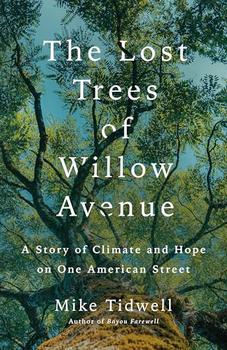Summary | Excerpt | Reviews | Beyond the Book | Readalikes | Genres & Themes | Author Bio

A Story of Climate and Hope on One American Street
by Mike Tidwell
By chance, around the time I moved to Willow Avenue in 1991 and fell in love with its trees, scientists began to unravel some of the inner workings and mysteries of these magnificent plants. Western societies for centuries have assumed trees were more or less mute objects—giant and useful and pretty to look at but the opposite of dynamic. But in the early 1990s, using radioactive isotopes pumped into the roots, researchers discovered trees are amazingly social creatures. They talk to one another underground, learn from one another, store knowledge, and live as families whenever they can, children next to parents.
The complex root system—interwoven with an even complexer network of symbiotic fungi—makes this possible. So extensive is the underground sharing of information through chemicals and even electrical pulses that many scientists call it "the wood wide web." Trees exchange sugar and other nutrients with each other. Mothers "nurse" their young with supplemental food passed root to root. All the while, aboveground, trees are talking, too, using scent and color to warn of attacking insects or unfolding drought.
More research has shown that trees like to sleep, they can tell time, they can taste. And almost certainly, they feel pain.
In fact, many foresters and arborists believe that when the pain becomes so great inside a tree's body—as during droughts, for example—the tree starts to scream. The trunk vibrates softly in the plant's version of vocal cords. Sonic tests have confirmed these vibrations inside distressed trees.
And inside Takoma Park, Maryland, sometime in 2018 or 2019, after months of pummeling record rainfall and then weeks of drought, it seems clear that that's what was happening to thousands of old oak trees here. Their bodies had begun to shake. Their trunks were vibrating.
They were screaming.
* * *
IT WAS ONE of the strangest weather patterns observed in the twenty-first century. The jet stream—that powerful global current of air—had dipped all the way south to the Gulf of Mexico by the middle of 2018. It abandoned its normal North American summer route across lower Canada. In the process, it pulled tons of moisture up from the Gulf, hurling it toward the mid-Atlantic.
By July, weather experts were calling it an "atmospheric river." There was so much moisture, flowing so fast, it was like a river in the sky, roaring inland. Every few days, the bottom would just fall out and the river crashed down upon the Eastern Seaboard.
From mid-May to early June, DC's Ronald Reagan Washington National Airport recorded a soaking ten inches of rain. Forty miles to the north, in Ellicott City, Maryland, ten inches of rain fell in two hours on May 27. A ten-foot wall of water barreled through the downtown, destroying almost everything. Watching the footage, you wonder: How can so much water crash into so many buildings so quickly? One National Guardsman was killed. Meteorologists called it a "one-thousand-year flood." It was the second one-thousand-year flood in two years in that same small town.
On Willow Avenue, my twenty-one-year-old dogwood tree was the first tree to die on the block. It was planted the month my son, Sasha, was born in May 1997. It drowned in the front yard, its roots waterlogged and rotten.
Across the street, the Millers' basement flooded as never before. The ground was completely soaked when a staggering four more inches of rain fell on July 21. There was nowhere for the liquid to go. Mud and debris overwhelmed an exterior drain, sending water into their basement—three inches deep—before Dave could start the cleanup.
There are different ways to explain what happened in 2018 in the DC region and beyond. Meteorologists refer to wind flows and land-ocean temperature contrasts, making it seem almost normal. But the truth is, it was just our turn.
Excerpted from The Lost Trees of Willow Avenue by Mike Tidwell. Copyright © 2025 by Mike Tidwell. Excerpted by permission of St. Martin's Press. All rights reserved. No part of this excerpt may be reproduced or reprinted without permission in writing from the publisher.
There is no worse robber than a bad book.
Click Here to find out who said this, as well as discovering other famous literary quotes!
Your guide toexceptional books
BookBrowse seeks out and recommends the best in contemporary fiction and nonfiction—books that not only engage and entertain but also deepen our understanding of ourselves and the world around us.